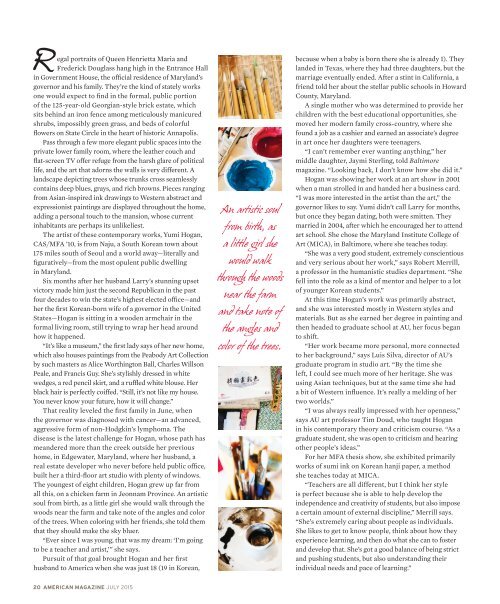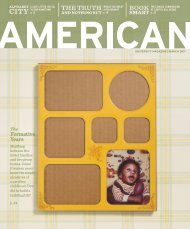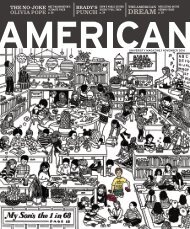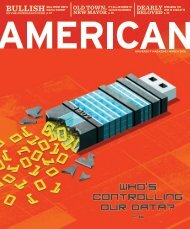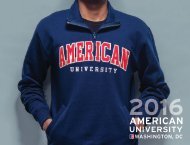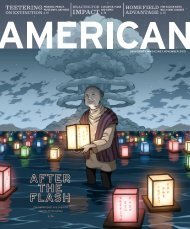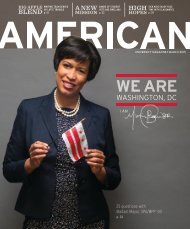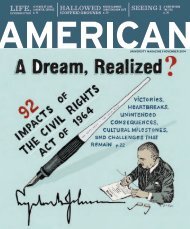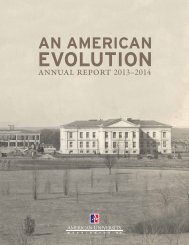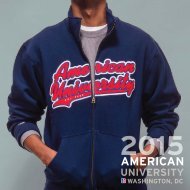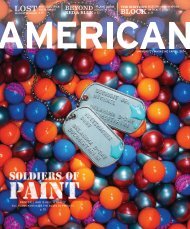American Magazine, July 2015
This issue, meet Maryland First Lady Yumi Hogan, learn about Kogod’s startup incubator, explore the Smithsonian’s new American Enterprise exhibit, hop on the Metro to Navy Yard—Ballpark, and get to know some of AU’s 1,200 Atlanta transplants. Also in the August issue: footwear on campus, 12 Eagles to follow on Twitter, and a new quiz with a tasty prize.
This issue, meet Maryland First Lady Yumi Hogan, learn about Kogod’s startup incubator, explore the Smithsonian’s new American Enterprise exhibit, hop on the Metro to Navy Yard—Ballpark, and get to know some of AU’s 1,200 Atlanta transplants. Also in the August issue: footwear on campus, 12 Eagles to follow on Twitter, and a new quiz with a tasty prize.
Create successful ePaper yourself
Turn your PDF publications into a flip-book with our unique Google optimized e-Paper software.
Regal portraits of Queen Henrietta Maria and<br />
Frederick Douglass hang high in the Entrance Hall<br />
in Government House, the official residence of Maryland’s<br />
governor and his family. They’re the kind of stately works<br />
one would expect to find in the formal, public portion<br />
of the 125-year-old Georgian-style brick estate, which<br />
sits behind an iron fence among meticulously manicured<br />
shrubs, impossibly green grass, and beds of colorful<br />
flowers on State Circle in the heart of historic Annapolis.<br />
Pass through a few more elegant public spaces into the<br />
private lower family room, where the leather couch and<br />
flat-screen TV offer refuge from the harsh glare of political<br />
life, and the art that adorns the walls is very different. A<br />
landscape depicting trees whose trunks cross seamlessly<br />
contains deep blues, grays, and rich browns. Pieces ranging<br />
from Asian-inspired ink drawings to Western abstract and<br />
expressionist paintings are displayed throughout the home,<br />
adding a personal touch to the mansion, whose current<br />
inhabitants are perhaps its unlikeliest.<br />
The artist of these contemporary works, Yumi Hogan,<br />
CAS/MFA ’10, is from Naju, a South Korean town about<br />
175 miles south of Seoul and a world away—literally and<br />
figuratively—from the most opulent public dwelling<br />
in Maryland.<br />
Six months after her husband Larry’s stunning upset<br />
victory made him just the second Republican in the past<br />
four decades to win the state’s highest elected office—and<br />
her the first Korean-born wife of a governor in the United<br />
States—Hogan is sitting in a wooden armchair in the<br />
formal living room, still trying to wrap her head around<br />
how it happened.<br />
“It’s like a museum,” the first lady says of her new home,<br />
which also houses paintings from the Peabody Art Collection<br />
by such masters as Alice Worthington Ball, Charles Willson<br />
Peale, and Francis Guy. She’s stylishly dressed in white<br />
wedges, a red pencil skirt, and a ruffled white blouse. Her<br />
black hair is perfectly coiffed. “Still, it’s not like my house.<br />
You never know your future, how it will change.”<br />
That reality leveled the first family in June, when<br />
the governor was diagnosed with cancer—an advanced,<br />
aggressive form of non-Hodgkin’s lymphoma. The<br />
disease is the latest challenge for Hogan, whose path has<br />
meandered more than the creek outside her previous<br />
home, in Edgewater, Maryland, where her husband, a<br />
real estate developer who never before held public office,<br />
built her a third-floor art studio with plenty of windows.<br />
The youngest of eight children, Hogan grew up far from<br />
all this, on a chicken farm in Jeonnam Province. An artistic<br />
soul from birth, as a little girl she would walk through the<br />
woods near the farm and take note of the angles and color<br />
of the trees. When coloring with her friends, she told them<br />
that they should make the sky bluer.<br />
“Ever since I was young, that was my dream: ‘I’m going<br />
to be a teacher and artist,’” she says.<br />
Pursuit of that goal brought Hogan and her first<br />
husband to America when she was just 18 (19 in Korean,<br />
An artistic soul<br />
from birth, as<br />
a little girl she<br />
would walk<br />
through the woods<br />
near the farm<br />
and take note of<br />
the angles and<br />
color of the trees.<br />
because when a baby is born there she is already 1). They<br />
landed in Texas, where they had three daughters, but the<br />
marriage eventually ended. After a stint in California, a<br />
friend told her about the stellar public schools in Howard<br />
County, Maryland.<br />
A single mother who was determined to provide her<br />
children with the best educational opportunities, she<br />
moved her modern family cross-country, where she<br />
found a job as a cashier and earned an associate’s degree<br />
in art once her daughters were teenagers.<br />
“I can’t remember ever wanting anything,” her<br />
middle daughter, Jaymi Sterling, told Baltimore<br />
magazine. “Looking back, I don’t know how she did it.”<br />
Hogan was showing her work at an art show in 2001<br />
when a man strolled in and handed her a business card.<br />
“I was more interested in the artist than the art,” the<br />
governor likes to say. Yumi didn’t call Larry for months,<br />
but once they began dating, both were smitten. They<br />
married in 2004, after which he encouraged her to attend<br />
art school. She chose the Maryland Institute College of<br />
Art (MICA), in Baltimore, where she teaches today.<br />
“She was a very good student, extremely conscientious<br />
and very serious about her work,” says Robert Merrill,<br />
a professor in the humanistic studies department. “She<br />
fell into the role as a kind of mentor and helper to a lot<br />
of younger Korean students.”<br />
At this time Hogan’s work was primarily abstract,<br />
and she was interested mostly in Western styles and<br />
materials. But as she earned her degree in painting and<br />
then headed to graduate school at AU, her focus began<br />
to shift.<br />
“Her work became more personal, more connected<br />
to her background,” says Luis Silva, director of AU’s<br />
graduate program in studio art. “By the time she<br />
left, I could see much more of her heritage. She was<br />
using Asian techniques, but at the same time she had<br />
a bit of Western influence. It’s really a melding of her<br />
two worlds.”<br />
“I was always really impressed with her openness,”<br />
says AU art professor Tim Doud, who taught Hogan<br />
in his contemporary theory and criticism course. “As a<br />
graduate student, she was open to criticism and hearing<br />
other people’s ideas.”<br />
For her MFA thesis show, she exhibited primarily<br />
works of sumi ink on Korean hanji paper, a method<br />
she teaches today at MICA.<br />
“Teachers are all different, but I think her style<br />
is perfect because she is able to help develop the<br />
independence and creativity of students, but also impose<br />
a certain amount of external discipline,” Merrill says.<br />
“She’s extremely caring about people as individuals.<br />
She likes to get to know people, think about how they<br />
experience learning, and then do what she can to foster<br />
and develop that. She’s got a good balance of being strict<br />
and pushing students, but also understanding their<br />
individual needs and pace of learning.”<br />
20 AMERICAN MAGAZINE JULY <strong>2015</strong>


